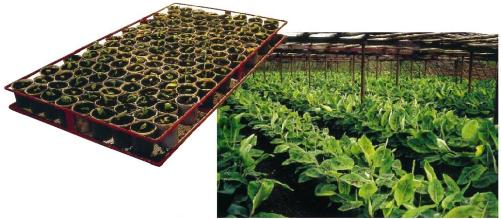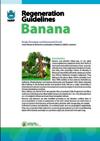CGKB News and events Banana
|
Importance and origin Banana (Musa spp.) is one of the most ancient fruit crops known and used by man. It originated in South-East Asia and was first domesticated some 7000 years ago. Today it is grown in every humid tropical and many sub-tropical regions. It is the fourth most valuable food crop after rice, wheat and maize. The fruit crop provides a staple food source for 400 million people, most important in East–Africa. About 95 million metric tons of bananas are harvested annually around the world, 30% of these being plantains. About 90% of the total production takes place on small-scale farms and it is used for home consumption or in domestic markets. The remaining 10% (dessert bananas) are mostly produced in Latin-America and Caribbean and commercialized in world trade.
Production of banana in the world
|
|
|
How is it consumed? For many people in the tropics, bananas are an essential component in their daily diet.
Bananas are essential for many people in the tropics
|
|
|
Which types exist? Bananas evolved from inter-and intraspecific hybridization between two diploid wild species of the genus Musa, sp. acuminata (AA) and sp. balbisiana (BB), the only species that set seeds. These crosses produced edible cultivars (all female sterile with various levels of male sterility) currently cultivated, with the following genomic configuration:
|
|
|
Further reading: Simmonds and Shepherd, 1955 |
Characterization of cultivated banana and wild types
|
Practicing characterization at a training course (photo: Bioversity) |
Contributors to this page: Bioversity International, France (Anne Vezina, Stéphanie Channeliere).
The Descriptors for Bananas, published in 1996 by Bioversity (then IPGRI and INIBAP), include the characterization descriptors developed by the French Agricultural Research Centre for International Development, CIRAD. This comprehensive list of 126 descriptors is intended to guide curators in deciding which ones are most useful to describe the material in their collection. It is not expected that all the descriptors will need to be recorded.
A set of Key access and utilization descriptors for banana have recently been developed by Bioversity International and an international advisory group (2009).
When to record descriptors
The best time to record the descriptors is when the fruit are well-filled, green-ripe or just turning yellow, and the rachis is at least 45 cm long. It should be noted however that, according to their nature, some of the descriptors will need to be recorded at a different time.
On a plant that loses its bracts, the optimal development stage to record descriptors can be confirmed by counting the number of nodes (the scars made by the fallen bracts) on the rachis, as shown below. Bracts fall off at the rate of one a day, revealing three parallel spirals. Counting 20 nodes on any of the three spirals means that plant flowered 60 days before. This is the point after which rapid change no longer occurs.
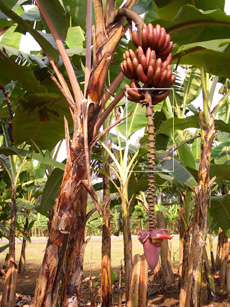 |
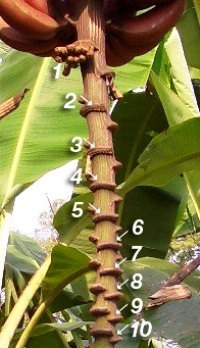 |
|
The photos above show the first ten nodes/scars of the first spiral, which continues on the back of the rachis. The spiral has to have at least 20 nodes to be at the optimal development stage for recording most of the descriptors. (photos: Bioversity) |
|
To ensure maximum expression of the characters to be recorded, the plants should be grown in an environment conducive to their development. The regeneration guidelines describe how to manage a field collection to obtain optimal growth conditions (see regeneration guidelines for banana).
Photographic descriptors
Photographic descriptors are useful to complement and corroborate the information obtained using the characterization descriptors. The photos can also be used by taxonomic experts to establish the identity of an accession. They should be taken when the characterization descriptors are recorded. Below are instructions on how to capture the photographic descriptors.
|
|
References and further reading
Bioversity International. 2009. Key access and utilization descriptors for banana genetic resources. Bioversity International, Rome, Italy. Available here.
IPGRI, INIBAP, CIRAD. 1996. Descriptors for Banana (Musa spp.). IPGRI, Rome, Italy; INIBAP, Montpellier, France; CIRAD, France. 55 pp. Available here.
Ploetz RC, Kepler AK, Daniells J, Nelson SC. 2007. Banana and plantain - an overview with emphasis on Pacific island cultivars. Available from: http://www.agroforestry.net/tti/Banana-plantain-overview.pdf. Date accessed: 23 March 2010.
Simmonds NW, Weatherup STC. 1990. Numerical taxonomy of the cultivated bananas. Tropical Agriculture 67 (1):90-92.
Simmonds NW, Weatherup STC. 1990. Numerical taxonomy of the wild bananas (Musa). New Phytologist 115 (3):567-571.
Simmonds NW, Shepherd K.1955. The taxonomy and origins of the cultivated bananas. Journal of the Linnean Society 55:302-312.
Field bank (regeneration) guidelines for banana
Contributors to this page: Bioversity International, France (Nicolas Roux), Bioversity International, Ethiopia (Michael Bolton, Alexandra Jorge); CIRAD, France (Jean-Pierre Horry, Tomekpe Kodjo); IITA, Nigeria (Dominique Dumet).
Field bank for banana
When are field banks used
|
Banana field collection (photo: Bioversity) |
Many important varieties of field, horticultural and forestry species, including banana, are either difficult or impossible to conserve as seeds (i.e. no seeds are formed or if formed, the seeds are recalcitrant) or to reproduce vegetatively. Hence they can be conserved as growing plants in field genebanks or in vitro (in tissue culture or cryo banks).
Banana stored in field genebanks have a lower risk of loosing genetic integrity (due to genetic drift) if the mother plants are maintained for many years and are readily available for study and use. However, bananas maintained in field genebanks are considerably more exposed to physical risks (climate, diseases, pests) and costs are higher for storage (labour, inputs and space) than for in vitro genebanks. This balance must be considered before taking the decision to establish a field genebank for banana, if other options are also possible.
Advantages of field genebanks
- Material can be evaluated and characterized while being conserved.
- Genotypes that commonly produce variants can be more easily identified and rogued out in the field than in vitro.
- Lower risk of loosing genetic integrity.
- Easy access for research, utilization and distribution.
- Establishment and maintenance of field genebanks requires limited technology.
Disadvantages of field genebanks
- Materials are susceptible to pests, diseases, adverse weather, theft and vandalism.
- Field genebanks require large areas of land, but even then genetic diversity is likely to be restricted.
- High maintenance costs (labour, inputs and space).
- Slow multiplication of material for distribution.
|
View regeneration guidelines in full (in PDF) |
Regeneration guidelines for banana
Note: These guidelines refer specifically to the regeneration of banana in field collections and include information on the establishment of a new field collection.
For regeneration or rejuvenation of banana in in vitro collections click here.
The information on this page was extracted from:
Tomekpe K. and Fondi E. 2008. Regeneration guidelines: banana. In: Dulloo M.E., Thormann I., Jorge M.A. and Hanson J., editors. Crop specific regeneration guidelines [CD-ROM]. CGIAR System-wide Genetic Resource Programme, Rome, Italy. 9 pp.
Before reading the regeneration details for this crop, please read the general introduction that gives the general guidelines to follow, by clicking here.
Introduction
Banana and plantain (Musa spp. L.) are giant monocotyledonous perennial herbs that thrive in the humid and subhumid tropics of low- and mid-altitude areas. They originate primarily from South-East Asia, with secondary centres of diversity in West and Central Africa (Plantain subgroup) and the East African highlands (Lujugira subgroup). They belong to the genus Musa, which comprises more than 1000 varieties in four sections: Australimusa, Callimusa, Rhodochlamys and Eumusa (Simmonds and Shepherd 1955). Most cultivated Musa belong to the Eumusa section and produce fruits that are a major commodity in international trade but are even more important as starchy staples in local food economies of many developing countries.
Most cultivars are derived from two species: Musa acuminata Colla (A genome) and Musa balbisiana Colla (B genome). Most edible banana are triploids (2n = 3x = 33), although there are a few diploid cultivars and even fewer tetraploid cultivars.
Bananas and plantains are also classified according to use (dessert, cooking, beer or processing/fibre) or mode of preparation of the fruit. Sweet bananas are eaten fresh or unprocessed but most bananas, and particularly plantains with orange pulp, are cooked. Cultivated bananas and plantains are parthenocarpic and are propagated vegetatively.
They are conserved in field collections as actively growing plants or in vitro as proliferating tissue. Wild relatives (normally non-parthenocarpic) are conserved in the same way. Bananas and plantains consist of an underground organ (corm) that bears roots, suckers or shoots and a pseudostem with leaves. The corm or rhizome is the true stem. Suckers develop initially as swollen buds from lateral meristems at leaf bases on the corm. A sucker has different developmental stages (Stover and Simmonds 1987): peeper, sword sucker and maiden sucker. The recommended stage for regeneration is the sword sucker (a sucker that is 50-150 cm in height with lanceolate leaves) followed by the peeper (a large green bud that has just emerged above ground). Among the followers or daughter plants, a sucker or ratoon is selected to succeed the mother plant. A group of suckers from a single parent is referred to as a stool or mat. A crop cycle is the time between planting and fruit harvest on the same mat. The second harvest from the mat is called the first ratoon crop (Gowen 1995).
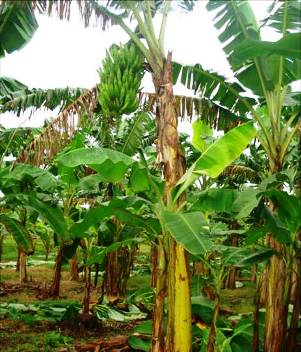 Description is an important step in regeneration: |
Choice of environment and planting
Climatic conditions
Banana grows well:
- In humid tropical lowlands between latitudes 20°N and 20°S.
- Between 100 m and 500 m altitude.
- Above 19°C mean minimum temperature (optimum average temperature is 27°C).
- In areas with >100 mm monthly rainfall (Robinson and de Villiers 2007).
However, banana can grow in a much wider range of climates within the tropics, with site selection mainly limited by soil type and rainfall.
Planting season
Planting can be done all year round if there is enough moisture. Planting should be done at the beginning of the rainy season.
Preparation for regeneration
When to regenerate
Regenerate field collections every four years to restore collections, as accumulated diseases and pests reduce plant vigour. Regeneration also allows maintenance (re-alignment) of planting pattern and optimal density since successor plants of banana emerge at variable distances away from the parent stand.
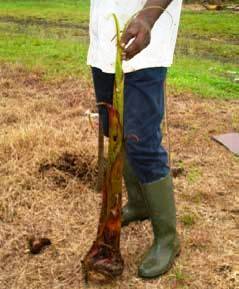 Sword sucker obtained from parent plant for regeneration (photo: Emmanuel Fondi) |
Field selection and preparation
- Banana field collections are maintained indefinitely. It is necessary to have twice as much space as occupied by the collection (i.e. if a collection of 700 accessions occupies 3 ha, you need to have 6 ha available) for fallowing which is essential for proper growth of accessions.
- The best soils for banana are deep, well-drained fertile loams with high water-holding capacity and organic matter content (Purseglove 1972).
- Select fields that were not under banana during the previous two years or that were planted to a non-host crop like pineapple.
- Choose soils with adequate drainage and where water-logging is not a problem.
Method of regeneration
Both parthenocarpic edible bananas and their wild relatives are regenerated vegetatively. In this way the genetic identity remains unchanged from one cycle to the next. To safeguard the entire biodiversity, it is necessary to regenerate all the accessions.
Planting layout, density and distance
The planting layout of a banana collection should take account of the genomic constitution of the varieties and the use types of the accessions. Make a field plan (electronic and hard copy). See sample plan below.

Divide the site into main blocks separated by 6-m-wide tracks. Blocks should correspond to the genomic group or the main subgroup, e.g. plantain. Assign block names and then:
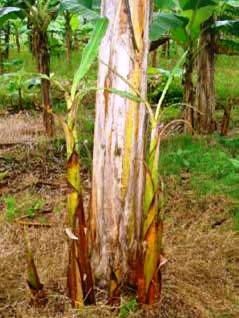 Parent plant with suckers to be used for regeneration. (photo: Emmanuel Fondi) |
- Further divide the blocks into bands directed at right angles to the blocks. The bands correspond to the different subgroups.
- Plant in single rows, with five plants per row.
- Use a plant spacing of 3 m between rows and 2 m within each row.
Source of planting material
- The best planting materials are sword or maiden suckers collected from the accession to be regenerated (see photo on the right), which do not develop broad leaves until they are more than 1 m high.
Selection of planting material
- Choose plants at flowering or at the end of the growing season.
- Plants should be free of undesirable variations in the cultivar characteristics.
The following diseases must be avoided: Moko disease due to Ralstonia solanacearum Smith, phylotype II, Xanthomonas wilt (bacteria wilt) caused by Xanthomonas vasicola pv. musacearum, Panama disease (Race 1 and 2) and other vegetative compatibility groups (VGCs) of Fusarium oxysporum f. sp. cubense, Banana bunchy top virus (BBTV), Banana bract mosaic virus (BBrMV).
Other pests and diseases, especially nematodes, weevils and other viral and bacterial diseases, should be absent or have a low prevalence in the field from which planting material is extracted. Monitor by regular field inspections.
Preparing planting material and method
- Suckers removed from the mother plant must be pared in the field to remove all the roots and diseased tissue before being transported (see photo below). Remove any suspect part of a different colour. Discard sucker if darkened galleries, dead or discoloured areas or other damage make up one quarter to one third of the sucker.
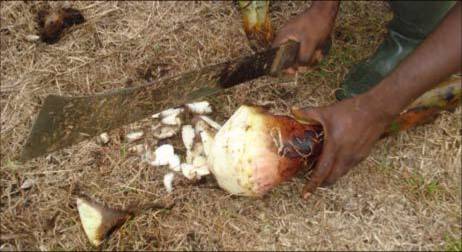 Paring of sucker to eliminate soil-born pests and diseases (photo: Emmanuel Fondi) |
- Disinfect the machete after each sucker in a 5% sodium hypochlorite solution or a 20% iodine solution to avoid spreading disease (bacterial wilt and Fusarium).
- Cut the pseudostem in cross section 10-15 cm above the corm to examine for any off-coloured rings, brownish spots or off-coloured liquid. Eliminate suckers or corms showing these characteristics.
- To prevent re-infection with banana weevil borer once sucker paring is complete, transport the suckers immediately to a site distant from any banana fields to limit the risk of weevils laying eggs in the planting material.
- Place identification tags on suckers and give particular care to the identity of suckers from each accession before removing them from the field.
- When the suckers are to be planted directly or into a multiplication plot, immerse them in hot water (30 seconds in boiling water or 20 minutes in water at 50°C) to kill weevil borer eggs and nematodes, if needed.
- Plant suckers directly in loose soil using hoes or spades if deep ploughing has been done.
- If deep ploughing is not done, plant suckers in square holes with sides of 40 cm and depth of 40 cm.
It is indicated to plant the suckers at once after their pulling up and treatment and if it is not possible, one or a few days afterwards suckers can however be stored for several weeks in a shaded dry area until planting is completed.
Labelling
- Place metallic identification plates at the head of rows to identify accessions (see photo below).
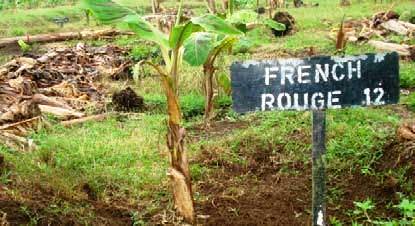
Metallic plate to identify accession (photo: Emmanuel Fondi) |
Crop management
Fertilization
Fertilizer practices vary widely according to climate, cultivar, yield level, soil fertility and production system. Before planting, take a composite soil sample from each block or from each soil type change. Analyse the sample to determine soil pH and micronutrient levels. This should provide a reliable recommendation for pre-planting application of lime (dolomitic or calcitic), K and P. The normal pH range is 5.8 to 6.5. Below this, lime application is required. Top dressing with N and K is recommended according to the expected yield level and results of soil analysis.
Weed management
Weeds can be manually or chemically controlled.
- Apply a post-emergent, non-selective systemic herbicide (e.g. glyphosate) two weeks before planting. Clear manually once a month during early stages of crop growth.
- Apply herbicide when the plants have grown tall enough to permit direct spraying, but apply with care as the banana plants are very sensitive to herbicides.
Mulching
Mulch with organic matter to reduce evapotranspiration and to increase the organic matter content of the soil. Elephant grass (Pennisetum purpureum Schumach.) is a popular mulch in Central Africa, particularly for plantains and diploid bananas. It is rich in potassium and improves soil fertility.
Pruning and de-suckering
- Prune once a month to eliminate withered leaves and reduce leaf disease pressure.
- De-sucker plants regularly to maintain a single successor sucker at a time. De-suckering should be carried out in such a way as to maintain the initial planting layout.
Irrigation
Irrigation is required during the dry season to keep the plants vigorous.
Common pests and diseases
Major pests of banana include nematodes, banana weevil borer, tomato semi-looper (Chrysodeixis acuta) and thrips.
Major diseases include Panama wilt (Fusarium oxysporum), bacterial wilt (Xanthomonas wilt), Erwinia rhizome rot, black and yellow Sigatoka (Mycosphaerella), cucumber mosaic virus (CMV), banana bunchy top virus (BBTV) and banana streak virus (BSV). Do not distribute accessions contaminated with viruses.
Pest and disease control
- Proper cultural practices, such as fallowing, balanced nutrition and weed control, help keep disease pressure at a minimum.
- The main pesticides required are insecticides and nematicides; about two applications are required per year.
- Sigatoka diseases are controlled by pruning infected leaves and/or applying fungicides. Viral diseases are major threats to a collection and are controlled by prevention, principally by controlling the source and the quality of material introduced in to the collection. Infected plants should be uprooted and destroyed as soon as they are identified.
Harvesting
The regeneration of bananas does not involve seeds. At maturity (when first ripe fruit appears on bunch), description is carried out and the fruits taken for consumption in the case of parthenocarpic edible banana types. For wild types, the entire plant is cut down and placed in the interline space.
Regeneration of wild banana
The regeneration procedures for wild banana should be the same as for edible types.
Monitoring accession identity
Comparisons with passport or morphological data
Accessions are characterized using minimum descriptor forms adapted from‘Descriptors for bananas’ (IPGRI/INIBAP, CIRAD 1996). Typical reference materials are photos and description forms.
Reference sources for comparison include Musalogue (Daniells et al. 2001) and the Musa Germplasm Information System (MGIS) database.
Compare the following major traits in characterization data:
- General plant appearance.
- Bunch characteristics.
- Male bud characteristics.
An accession is declared true to type (TTT) if its traits match those of the known reference.
In cases where they do not match with the reference, it is declared either as miss-labelled (ML) or off type (OT). If it is mislabelled, its true identity is sought; whereas if declared off-type, it is destroyed and the right accession re-introduced in to the collection.
Documentation of information during regeneration
The following information should be collected during regeneration:
- Regeneration site name and map/GPS reference.
- Name of collaborator.
- Field/plot reference.
- Accession number, accession code in the institute, ITC code; population identification.
- Source of suckers.
- Abnormalities on the mother plant and sucker.
- Generation or previous multiplication or regeneration (if generation is not known).
- Preparation of planting materials (pre-treatments).
- Planting date and density.
- Field layout used.
- Field management details (watering, fertilizer, weeding, pest and disease control, stresses recorded, others).
- Environmental conditions (altitude, precipitation, soil type, others).
- Emergence in the field (number of plants germinated).
- Number of plants established.
- Days from planting to flowering.
- Agronomic evaluation; agromorphological traits recorded.
- Comparisons with reference materials (record any identification numbers or references of any samples taken from this regeneration plot).
- Others.
References and further reading
Daniells J, Jenny C, Karamura D, Tomekpe K. 2001. Musalogue: Diversity in the genus Musa. IPGRI/INIBAP/CTA, Rome, Italy. Available from: http://www.bioversityinternational.org/publications/publications/publication/issue/imusailogue_diversity_in_the_genus_imusai.html (16 MB). Date accessed: 23 March 2010.
IPGRI, INIBAP, CIRAD. 1996. Descriptors for Banana (Musa spp.). IPGRI, Rome, Italy; INIBAP, Montpellier, France; CIRAD, France. 55 pp. Available here.
Lassoudiere A. 2007. Le bananier et sa culture. Editions Quae, Versail es Cedex, France. 383 pp.
Purseglove JW. 1972. Tropical Crops. Monocotyledons. Vol. 2. Longman, London, UK.
Robinson JC, de Villiers EA. 2007. The cultivation of banana. ARC-Institute for Tropical and Subtropical Crops, Nelspruit, South Africa/Du Roi Laboratory, Letsitele, South Africa. 258 pp.
Simmonds, N.W. and Shepherd, K. 1955. The taxonomy and origins of the cultivated bananas. Journal of the Linnean Society (Bot.), 55(359), p. 302-312 Abstract available from: www3.interscience.wiley.com/journal/119777761/abstract?CRETRY=1&SRETRY=0. Date accessed: 23 March 2010.
Stover RH, Simmonds NW. 1987. Bananas. Longman Scientific and Technical, New York, USA. 468 pp.
Swennen, R. 1990. Plantain Cultivation under West African Conditions: A Reference Manual. IITA, Ibadan, Nigeria. 24p.
Acknowledgements
These guidelines have been peer reviewed by Sebastião de Oliveira e Silva, Centro Nacional de Pesquisa de Mandioca e Fruticultura Tropical (CNPMF), Brazil; Wayne Hancock, Bioversity International, Ethiopia; and Jeff Daniells, Department of Primary Industries & Fisheries, Queensland, Australia.
Health diagnosis and testing of banana genetic resources
Contributors to this page: Bioversity International, Belgium (Ines Van den Houwe); IITA, Nigeria (Dominique Dumet, Badara Gueye).
List of pests and diseases of quarantine importance for banana
The list below mentions some of the pests/diseases that were considered important worldwide, but many of them may or may not have relevance in specific countries. It also does not consider pests/diseases of limited relevance (e.g. only important in very few countries).
America has the greatest diversity of banana pests, followed by Africa and then Asia. Damage in Africa is often high due to the lack of natural predators of pests. Damage is greatest in the dry season or in dry areas with low or irregular rainfall.
- The green mite (Mononychellus tanajoa) (America and Africa) and the mealybug (Phenococcus manihoti and P. Herreni) cause major damage in Africa.
- Whiteflies (Aleurotrachelus socialis and A. aepim), hornworm (Erinnyis ello), stemborers (Chilomina clarkei), burrower bugs (Sternocoelus manihoti and Tropidozineus fulveolus), thrips (Frankliniella williamsi) and lacebugs (Vatiga manihoti, V. illudens and Amblydtira machalana) are a problem in America.
- While scales (Aonidomytilus albus), termites and grasshoppers are widely reported.
- Amongst the main banana diseases there are the complex of:
- Banana mosaic diseases (CMD) caused by the African banana mosaic virus (ACMV), the East African banana mosaic virus (EACMV) and by the South African banana mosaic virus (SACMV).
- The banana brown streak virus (CBSV) in Africa.
- In South America, the main viral diseases are caused by the banana common mosaic virus (CsCMV and CsXV) and by the banana frogskin virus (CFSV).
- Other diseases like banana bacterial blight (CBB) or those caused by fungi, like banana anthracnose and root rot, are important worldwide.
Additional information is available on this website in the section Safe Transfer of Germplasm (STOG).
Options for testing procedures
Recommended methods to detect the presence of each pest or disease.
Viruses
Any accession officially deposited in the genebank (regardless of its origin) should have a representative sample indexed for banana viruses.
There are three Virus Indexing Centres (VIC) - CIRAD in France, QDPI in Australia or PPRI in South Africa - recognized by Bioiversity, using standard protocols as described in the FAO/IPGRI Technical Guidelines for safe Movement of Germplasm for Banana (FAO/IPGRI 1996).
- After the initiation phase, seven cultures should be produced from one selected culture derived from one single shoot tip (meristem).
- Five cultures should then be regenerated into rooted plants that will be provided to one of the VICs and four plants should be tested.
- The two remaining cultures remaining at the in vitro genebank should be used for further multiplication.
- The plants should be cultured in a screen house for six months. At three months intervals, the plants should be visually examined for virus symptoms relevant in the genebank regions.
- Indexing for Banana Bunchy Top Virus (BBTV), Cucumber Mosaic Virus (CMV) and Banana Bract Mosaic Virus (BBrMV) should be done by ELISA (Enzym-linked immunosorbent assay) or PCR.
- For Banana Mild Virus (BanMMV) and Banana Streak Virus (BSV), PCR and immunosorbent electron microscopy should be used using a partially purified virus preparation and a mixture of polyclonal antisera.
- Electron Microscopy is used to detect unidentified/uncharacterized virus (-like) particles.
- If the tests indicate that the accession is infected with one or more viruses, the accession is categorized as ‘virus-positive’ and the accession should be subjected to virus therapy, if eradication methods are available.
- If the test results for all replicate plants of an accession are negative, the accession can be categorized as ‘virus-negative’ and released for international distribution.
Fungi
- Blotter test, agar test, washing test, direct visual inspection.
Bacteria
- Seedling symptom test, dilution plating test.
Weeds
- Direct visual inspection.
Insects
- Direct visual inspection.
Nematodes
- Direct visual inspection.
Testing intervals/seasons
Testing before the material is introduced into the genebank or to the field is important to reduce transfer of diseases or pests.
Virus
- Test seedlings before transfer to the field for regeneration or during regeneration, and rogue infected material.
Fungi
- Test plant propagules on entry to genebank and regularly thereafter.
- Rogue infected material.
Bacteria
- Test plant propagules on entry to genebank and regularly thereafter.
- Rogue infected material.
Weeds, insects and nematodes
- Test plant propagules on entry to genebank and regularly thereafter.
- Rogue infected material.
Recording information during health diagnosis
The following information should be recorded for each health diagnosis step:
- Site name and map/GPS reference.
- Name of collaborator.
- Field bank site name (a code to identify the site location).
- Plot reference (the plot number at the field site).
- Accession number; population identification.
- Name of staff (name of staff recording the data).
- Date of monitoring (date when data is collected).
- Date of test (the date that the test was commenced).
- Number of replications (the number of replicates in the test).
- Size of the samples per replication /li>
- Pre-treatments (pre-treatments used for the test).
- Media (the media used for the test, e.g. for fungi).
- Material (which plant part used).
- Pathogen tested (name of pathogen tested).
- Test method (method used).
- Percentage of infection (% of plants or samples infected).
References and further reading
Diekmann M, Putter CAJ, editors. 1996. FAO/IPGRI Technical Guidelines for the Safe Movement of Germplasm. No.15. Musa spp. 2nd edition. Publisher: Food and Agriculture Organization of the United Nations, Rome; International Plant Genetic Resources Intstitute, Rome, Italy. 28 pp. Available here.
Helliot B, Panis B, Frison EA, De Clercq E, Swennen R, Lepoivre P, Neyts J. 2003. The acyclic nucleoside phosphonate analogues, adefovir, tenofovir and PMEDAP, efficiently eliminate banana streak virus from banana (Musa spp.). Antiviral Research (NLD), 59 (2):121-126. An abstract of this publication can be read here.
Van den Houwe I, Guns J, Swennen R. 1998. Bacterial contamination in Musa shoot tip cultures. International Symposium on Banana in the Subtropics. Acta Horticulturae 490:485-492. An abstract and purchase of the publication is available here.
Van den Houwe I, Panis B, 2000. In vitro conservation of banana: medium term storage and prospects for cryopreservation. Razdan MK, Cocking E, editors. Conservation of Plant Genetic Resources in vitro. Vol. 2. M/S Science Publishers, USA. pp. 225-257.
Van den Houwe I, Panis B, Arnaud E, Markham R, Swennen R. 2006. The management of banana (Musa spp.) genetic resources at the IPGRI/INIBAP gene bank: the conservation and documentation status. In: Segers H, Desmet P, Baus E, editors. Tropical biodiversity: science, data, conservation. Meeting: 3rd GBIF Science Symposium, Brussels, 18-19 April 2005. pp. 141-150. Available here. (8 MB)
Van den Houwe I, Swennen R. 2000. Characterization and control of bacterial contaminants in in vitro cultures of banana (Musa spp.). Meeting: International Symposium on Methods and Markers for Quality Assurance in Micropropagation. Acta Horticulturae
530:69-79. An abstract and purchase of the publication is available here.
Establishment of aseptic cultures of banana
|
Mother plant and young shoots – source of material (photo: IITA)
|
Contributors to this page: Bioversity International, Belgium (Ines Van den Houwe); IITA, Nigeria (Dominique Dumet, Badara Gueye).
New accessions can be received as small samples of in vitro cultures from other collections, seeds of wild types or as classical vegetative propagation materials (apex-containing parts of the banana plant). When materials come from the field, a series of procedures are required and are described below:
Initiation of shoot tip cultures from suckers
In Musa, explants can be obtained from all plant parts that contain a shoot meristem: the parental pseudo stem, its suckers, peepers, sword suckers, lateral buds or very small eyes.
- Explants should preferably be isolated from young, vigorous and healthy looking suckers of 40-100 cm in height with a corm diameter of about 10 cm.
- These should be collected from acharacterized flowering mother plant to guarantee trueness-to-type.
Usually only the apical meristem is available from a trimmed sucker. Eventually, smaller buds (sleeping eyes) on the corm can also be used as explants for tissue culture initiation.
Explant isolation and disinfection
- Excise from the sucker a cubical block of tissue (2x2x2 cm) containing the apical meristem.
- If there are buds on the corm surface present, excise the buds surrounded by 0.5 cm of corm tissue.
Surface sterilization of explants
- Transfer each cube of tissue to a different Erlenmeyer flask.
- Soak each individual cube of tissue in ethanol (96%) and shake gently.
- Immediately decant and rinse for 30 seconds in sterile deionised water.
- Transfer the Erlenmeyer flask to a laminar air flow cabinet.
- Emerse each plant tissue cube for 20 minutes in a 2% hypochlorite solution or diluted commercial bleach solution supplemented with a few drops of Tween 20 (surfactans). Liquid dish-washing detergent can be used if no Tween is available.
- Cover the Erlenmeyer flasks with a glass petri dish lid and swirl the solution frequently.
- Decant the hypochlorite solution.
- Then rinse three times in the space of ten minutes with sterile deionised water and decant.
Excision of explants
Shoot apices of bananas are enclosed in many tightly overlapping leaf initials. The shoot tip is about 2-5 mm in size and consists of the meristem covered with several leaf primordia supported on a small base of corm tissue.
- Remove the outer tissue that was exposed to the disinfectant solution from all sides of the cube.
- Sterilize dissection instruments repeatedly during manipulation by flame of glass bead sterilizer.
- Remove stepwise the covering leaf primordia, cut away as much corm tissue as possible, as this causes blackening of the culture during initiation.
In case of high risk of bacterial contamination, i.e. when suckers are harvested during the wet season, it is recommended to excise a smaller explant consisting of the meristem covered with 1-2 leaf primordia (1 mm).
- To excise the meristem tip, place the excised shoot tip under a dissecting microscope (working in a laminar flow cabinet) and further reduce the size by removing leaf primordia and some corm tissue at the base of the explant.
Tissue culture initiation
- Immediately place the excised explant onto culture initiation medium.
- Push the explant slightly into the culture medium to ensure good contact.
- Keep the cultures in complete darkness for one week to reduce blackening (photo-oxidation of polyphenols).
- Growth of the tissue should start about two weeks after inoculation, accompanied by a swelling of the leaf sheet tissue and corm tissue, a change of colour from white to green, and abundant oxidation of polyphenolic compounds that are released from the corm tissue (blackening of the tissue and surrounding growth medium).
- Transfer the explants to fresh medium every two weeks during the first eight weeks in culture.
- Trim the blackened and/or swollen corm tissue, if necessary, leaving the viable leaf primordia tissue of the explant intact.
- After 10-12 weeks the explant will develop into a shoot.
- Record the survival rate and visible contamination at each transfer for each replicate.
The size of the explant is an important factor in the successful culturing of shoot tips of bananas. Very small explants increase the chance of producing bacteria-free and virus-free cultures, but the mortality rate is high. Intermediate sized explants produce clean vigorous cultures that multiply rapidly whereas very large explants tend to show more blackening and contamination, and thus lower rates of successful tissue culturing.
Initiation of tissue cultures from seeds
For wild banana species, seeds can also be used to initiate tissue cultures, if no vegetative propagation material is available. However germination of banana seeds is known to be low and erratic, therefore preference is given to direct culturing of the axenic embryo isolated from the seed (= embryo rescue).
Surface disinfection of banana seeds
- Soak the seeds for 2-3 days in tap water, without stirring, in an Erlenmeyer flask. Refresh the water daily in order to avoid fungal contamination or growth.
- Soak the seeds for two minutes in EtOH (95 % v/v) in an Erlenmeyer flask and cover the flasks with a lid.
- Decant and transfer the flasks to a laminar air flow cabinet. Disinfect the seeds in a 1.5% hypochlorite solution and 1-2 drops of Tween for 20 minutes and shake gently. Wash the sterilized seeds with sterile deionised water rinsing twice in 15 minutes.
Embryo isolation
- Use forceps to fix the seed on a sterile cutting pad.
- Cut the seed lengthwise next to the micropyle.
- Remove the plug and pick up the embryo.
- Place the embryos on embryo germination medium in glass test tubes.
- Incubate the embryos under normal conditions for banana shoot tip cultures.
Germination can start about two days after inoculation, accompanied by a colour change from white to yellow and abundant formation of root hairs. Once cultures are successfully initiated, regular testing of the plant material for asepsis should start.
Contamination indexing (bacteria)
A primary requirement in the establishment and permanent maintenance of an in vitro collection is the asepsis of the tissue cultures. Sterility of the cultures is also of paramount importance for their intercontinental exchange and whenever cultures are used for various research purposes.
To safeguard the in vitro cultures against microbial contamination, and to prevent the spread of contaminants in the tissue culture system, monitoring of the material for asepsis should be performed at crucial steps (see Tissue culture testing below) and at regular intervals during the processing of material in the genebank.
Visual examination
- Bacterial contamination can be detected as faint ‘clouds’ in the medium around the basal part of the explants or culture. Therefore, the use of a clear gelling agent (Gelrite) in tissue culture will facilitate the detection of contamination.
- Sometimes even colony growth is detected around the tissue on the surface of the growth medium.
Most of the time however the contaminants remain deep seated inside the plant tissue and only appear in the growth medium under favourable conditions (increased sucrose concentration, change of pH of the medium, increase of the ambient temperature, deterioration of the plant tissue etc.).
Tissue culture testing
Tissue culture testing should usually be done upon introduction of new material, during storage and at annual subculturing. The screening test is simple and non-destructive. Testing involves streaking of the basal part of the shoot tip onto a semi-solid bacteriological medium.
- The test should be done at subculturing just before transferring the explant to the growth medium.
- A single shoot tip should be isolated from the culture and trimmed to a suitable size for transfer to fresh culture medium.
- The corm basis of this shoot tip should be streaked three times onto bacteriological medium and immediately placed onto plant growth medium.
- The petri dishes should be sealed with parafilm and incubated at 28°C.
- The standard testing medium is a broad spectrum bacteriological medium, which allows growth of a wide range of bacteria. The medium includes nutrient agar (8%), enriched with yeast extract (5 g/l) and glucose (10 g/l).
- Most bacteria are fast growing and will appear on the medium after two or three days, but slow growing contaminants may require up to eight weeks to appear on the medium. It is thus important to observe the medium for at least two months after testing.
-
In case of inconclusive results, alternative and complementary detection methods can be applied:
- Using specific/selective growth medium.
- Macerating the tissue and incubating in liquid the bacterial growth medium.
- Using polymerase chain reaction (PCR) methods.
Decontamination treatment
Contaminated cultures should be eliminated by autoclaving. However, when all replicates of one accession at initiation or in storage are tested positive, contaminated material cannot simply be discarded as the accessions may be unique and difficult to replace. They should then be subjected to a decontamination treatment.
- Before applying a decontamination treatment it is recommended to characterize the isolated bacteria in order to determine the most effective method of eradication.
- For routine application, meristem culture, for which only a rough characterization of the contaminant is required, is preferred over treatments with antibiotics of which the therapeutic success depends on the identification of the contaminant, bacterial sensitivity and phytotoxicity. Moreover, the application of antibiotic agents may involve the risk of developing resistant bacterial strains.
Elimination of bacteria through meristem culture
This technique involves the isolation of aseptic meristems from the contaminated in vitro cultures. Depending on the type of contaminating bacteria, the eradication method is further refined by subjecting either contaminated in vitro or greenhouse grown contaminated plants to meristem culture.
- Culturing 1 mm sized meristems, directly isolated from contaminated in vitro plants, is found most effective to eliminate bacteria like Bacillus sp.
- The shoot tip must be isolated from the contaminated culture and further reduced to 1 mm in length under a dissecting microscope. Young leaves must be removed until the dome covered by two to three leaf primordial remains.
- It is important that the corm tissue is carefully and maximally removed, as bacteria often reside in this tissue.
- The excision of the meristem tip should be done under stringent aseptic conditions in order to minimize the risk of transferring bacteria to the aseptic inner meristematic zone of the explant.
- It is essential that the explant material only comes into contact with sterile instruments and surfaces. Between use, forceps and scalpels should be sterilized (in a glass bead sterilizer or flame) and the cutting pad should be sterilized before the surface comes into contact with a freshly cut tip.
Elimination of bacteria from greenhouse plants
In some cases, for instance when the tissue cultures are contaminated with very small sized bacteria, the method described above is less effective. For a successful elimination of these bacteria, the explant size might need to be further reduced. These smaller sized explants, however, often fail to establish in vitro. Therefore, an alternative approach to eliminate bacteria is to isolate explants from greenhouse plants, acclimatizing the in vitro plants.
- The contaminated in vitro plants should be transferred to potting soil in PET pots in a greenhouse and grown for a period of 3-6 months or until the stems reach a diameter of at least 5 cm.
- The plants should be kept dry for 2-3 weeks and then explants of 1-3 mm tips can be isolated to re-initiate in vitro cultures.
- The newly established cultures should be re-tested for at least five subculture cycles in order to confirm their bacteria-free status.
Antibiotic treatments
An antibiotic treatment involves exposure of the contaminated shoot tip material to a bactericidal concentration of an antibiotic agent without affecting the growth of the shoot tip.
The antibiotic most often used is rifampicin. This antibiotic is able to kill Gram+ and Gram- bacteria without affecting the growth of the banana shoot tip (the MBC of rifampicin does not exceed the phytotoxic concentration). Other antibiotic agents tested seemed to be ineffective on most of the bacterial isolates and/or had a toxic effect on the plant tissue.
- Prepare liquid MS-based regeneration medium containing rifampicin HCl (100 mg/l) in Erlenmeyer flasks. Place one contaminated tip of 0.5 mm in 10 ml medium in an Erlenmeyer flask and incubate for 30 days at 28°C in light on a rotary shaker (60 rpm) and light intensity of at least 25 mµ m² s-1.
- After one month, the treated plant material should be taken out of culture. The aseptic shoot tip should be excised and cultured on a fresh antibiotic-free medium.
- The newly established cultures should be re-indexed for at least 5 subculture cycles in order to confirm their bacteria-free status.
References and further reading
Van den Houwe I, Panis B, 2000. In vitro conservation of banana: medium term storage and prospects for cryopreservation. Razdan MK, Cocking E, editors. Conservation of Plant Genetic Resources in vitro. Vol. 2. M/S Science Publishers, USA. pp. 225-257.
Van den Houwe I, Guns J, Swennen R. 1998. Bacterial contamination in Musa shoot tip cultures. Acta Horticulturae 490: 485-492.
More Articles...
- Rejuvenation of banana tissue culture
- In vitro conservation of banana genetic resources
- Slow growth storage of banana germplasm
- Cryopreservation of banana apical meristems
- Cryopreservation of banana meristem clusters (cauliflower-like structures)
- Cryo storage for banana genetic resources
- Viability and monitoring for banana (field)
- Distribution of banana genetic resources
- Field genebank for banana
- Safety duplication of banana genetic resources
Subcategories
-
main
- Article Count:
- 2
-
Registration of Musa
Registration and information systems - Importance and uses
Registration is the first step after acquisition of a sample in any genebank. Collections in genebanks are the genetic base for current and future breeding programs and a source of safety material for distribution to researchers and other users. It is essential that samples are all properly documented from the moment they enter a genebank as well as through all subsequent genebank operations.
A step by step guideline can be seen by clicking here.How should it be done?
Information systems
An information management system must be created in each genebank. This database must be searchable by the genebank curators and staff for specific information through a range of queries.
Numbering and labelling systems
Consecutive alpha numeric or numeric codes must be used for each new accession acquired. This code must be linked to all subsequent information about this sample: passport data, designation status and taxonomic information. The information system must keep a record of genebank operation data, including storage location, stocks, monitoring, health tests and the distribution status. The same system must also manage germplasm orders, shipment related information and files genebanks ‘contacts’ information.
Bar-coding is a useful tool that can compliment a genebank information system.
Extra samples
A separate subset of materials should be kept after registration to be regenerated under greenhouse conditions for harvesting leaf samples that can be processed for DNA/lyophilized leaf bank. These banked leaf materials can serve as a voucher for the germplasm stored in the active and base collections and samples can be made available to users for research in gene discovery and function, marker development and detailed genotypic characterisation. Method to be detailed by INIBAP
Musa Germplasm Information Systems (MGIS)
In 1997, INIBAP laid the basis for a global information system for Musa through the release of MGIS. The aim of the system was to enhance knowledge on Musa diversity, to help rationalizing conservation and to improve the use of banana genetic resources though a facilitated access to comprehensive information.
In 2005, the MGIS database contained key information, including passport data, botanical classification, morpho-taxonomic descriptors and characteristics such as agronomic traits, disease resistance, stress tolerance, biochemical or molecular genetic markers, and plant photographs as well as GIS information on 5188 accessions managed in 18 banana collections (link to the list of collections) around the world making it the most extensive source of information on banana genetic resources.
The database is publicly accessible through the internet at MGIS homepage.htm or at www.mgis.grinfo.net. This global database can be queried on the identity, origin, characteristics and distribution of the individual accessions in the collections. This allows curators of the participant institutions worldwide to share and compare their data. The database is also particularly helpful for various germplasm users namely breeders, researchers and farmer communities, in locating alternative sources of banana germplasm and identifying the most appropriate accessions with particular traits of interest.Homepage of the MGIS website (click on the picture if you wish to go there now)
Further reading:
Van den houwe et al., 2005 (The management of banana (Musa spp.) genetic resources at the IPGRI/INIBAP gene bank: the conservation and documentation status
Calles et al., 2003 (Best Practices for Genebank Management)- Article Count:
- 1
-
Conservation of musa
- Article Count:
- 4
-
In vitro bank for banana
- Article Count:
- 4
-
Cryopreservation for musa
- Article Count:
- 3
-
In the field for musa
- Article Count:
- 3
-
Safety duplication of musa
No. of samples (tubes) per line or cultivar
Size of container
Kind of medium
Amount of medium
Labeling
Placement of label
Bioversity - written directly on cryotubes using pencil
IITA - higher halfLabeling material
Bioversity - not applicable
IITA - marker on parafilm for tubes, tape on polyethylene bagsLabel information
Bioversity - accession ID, freezing date, experiment number
IITA - accession number, line number and date of last introduction
Viability testing
Conditions or timing when the test is conducted
After being one hour in liquid nitrogenNo. of samples for testing
Bioversity - 3 cryotubes per accession (experiment)
IITA – 1-5 seedlingsCriterion for long-term storage
At least 95% certainty that a minimum of 1 plant can be regenerated per experimentTransport
Type of container
Bioversity - dry shipper
IITA – plastic boxesMethod and duration
Bioversity - Air courier or hand carried
IITA - car (4x4) 5 to 6 hours driveConditions
Bioversity - Frozen in liquid nitrogen
IITA - ambientFrequency of shipment
Bioversity - Initially 3 to 4 x a year; once a year thereafter
IITA – 3 to 4 months
Genebank for safety storage
Bioversity - IRD, France & KULeuven, Belgium
IITA - IITA Cotonou, Benin
Storage
Type of storage
Bioversity – Cryopreservation in liquid nitrogen tank
IITA – Tissue culture slow growthType of container
Bioversity - 2mL cryotubes
IITA - Polyethylene bags (13 x 1.3 cm)Temperature (in degrees Celcius)
Bioversity – (-196 oC)
IITA – 18oCLife expectancy of clones
Bioversity - Indefinite
IITA – 4-6 monthsBack-up generator
Bioversity - none
IITA - noneOther features
Availability of liquid nitrogen alarm systemData arrangements
Bioversity - Germplasm ID, inventory of box content sent with samples
IITA - mport permit stating list of accession transferred, endorsed by PQS prior to departure Report at boarder PQS office
Provision for replacement of germplasm
Bioversity - If less than 95% certainty that one minimum plant can be regenerated per experimentProvision for return of germplasm
Bioversity - Loss of samples from LTS at Bioversity ITC; sample provided by the duplication site on Bioversity's requests on a 6 month written notice
IITA - Repatriation permit to ask when needed- Article Count:
- 1








